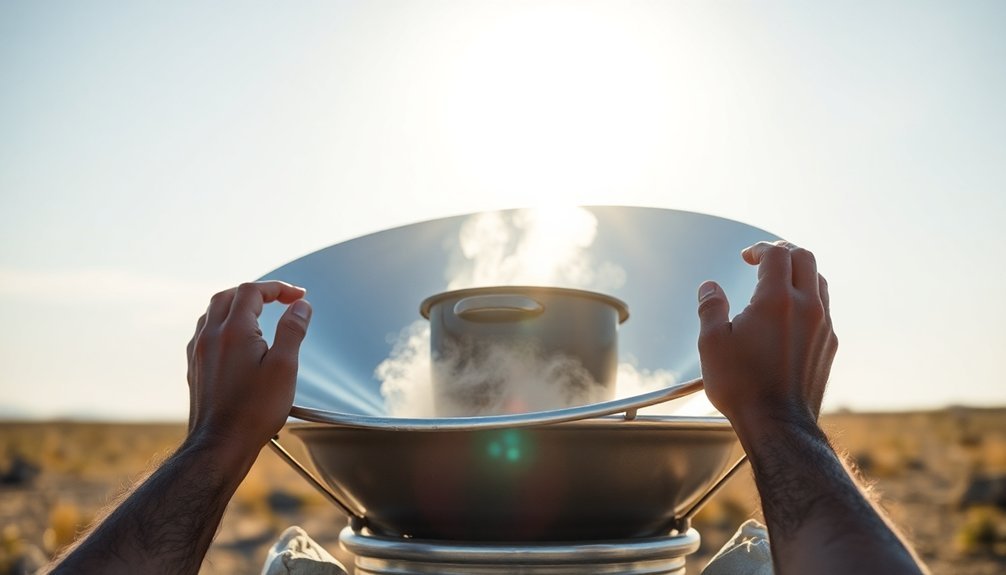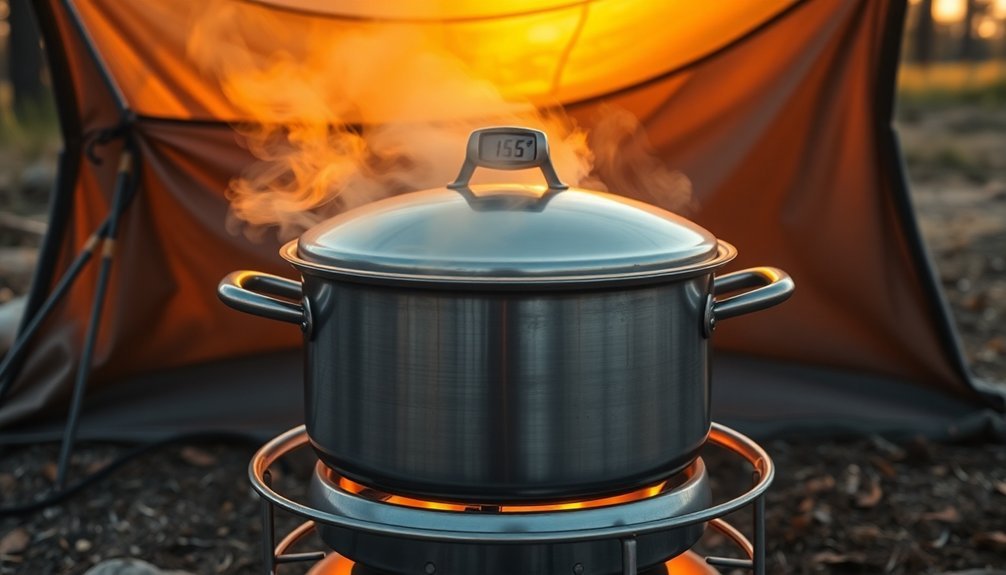You'll keep your outdoor cooking on track during windy conditions with three proven methods. First, position your cooking setup in a sheltered spot and use sturdy blocks or stones for stability. Second, create effective wind barriers using simple materials like cardboard, bricks, or logs positioned around your cooking area. Third, adjust your cooking times and temperatures – add 10-20% more time and monitor heat levels frequently to maintain consistent cooking conditions. By mastering these wind-resistant techniques, you'll discover even more ways to become an all-weather outdoor cooking expert.
Positioning Your Solar Cooker

Four key factors determine successful solar cooking: location, orientation, angle, and stability.
To start, you'll need to find a dry, level surface with unobstructed sunlight throughout your cooking time. Avoid areas where shadows might fall on your cooker.
For ideal sun exposure, position your cooker's front panel eastward for noontime meals or westward for evening cooking. You'll want to adjust the reflective panels every 20 minutes to track the sun's movement. A parabolic reflector cooker can reach temperatures up to 500°F when properly positioned.
When it's windy, secure your cooker with large stones or bricks to prevent tipping.
Don't forget to place your pot on a stand or stones inside the heat trap bag – this creates an insulating air layer underneath.
Keep your cooker sealed tight to maintain temperature, and use materials like foam trays or newspapers for extra insulation.
Wind-Blocking Setup Techniques
Setting up effective wind blocks is the next step after positioning your solar cooker properly. You'll want to create a sturdy barrier against gusts while maintaining your cooker's stability.
You can construct a foldable wind block using cardboard and duct tape, which helps retain heat and improves cooking efficiency. Strong winds can cause major cooking disruptions when not properly addressed.
For solar ovens like the Global Sun Oven, place bricks, cinder blocks, or logs firmly against each side and brace the back leg. You can enhance stability by using bungee cords attached to anchor points or a plywood base.
If you're using panel cookers like the Cookit, secure them with rocks on the edges and inside the panels. For extra protection, place your panel cooker in a large bucket and use guy lines made from rope or wire to anchor it down.
Time and Temperature Adjustments

When wind affects your cooking setup, understanding how to adjust times and temperatures becomes essential for success.
You'll need to increase cooking times by 10-20% and monitor temperatures more frequently, as wind can quickly cool your cooking equipment.
Keep a thermometer handy to check both the cooking temperature and food's internal temperature.
If you're using a charcoal grill, you'll likely need to add more fuel to maintain steady heat.
While increasing temperature from 375°F to 425°F typically reduces cooking time by 20-25%, wind can diminish this effect.
Remember to preheat your cooking device thoroughly and flip food regularly for even cooking.
Different methods require different adjustments, so stay attentive to visual cues and temperature readings. Using lower shelf positions in your oven can help maintain more consistent temperatures during windy conditions.
Don't rush the process – patience and constant monitoring are your best tools for success.
Frequently Asked Questions
Can I Use a Solar Cooker During Cloudy and Windy Conditions?
Yes, you can use a solar cooker in cloudy and windy conditions, but you'll need longer cooking times for clouds and must secure your cooker with bricks or windbreaks to prevent tipping in wind.
What Alternative Cooking Methods Work Best When Wind Prevents Outdoor Grilling?
You'll find camping stoves and indoor methods most reliable in windy conditions. Try using a protected area with windbreaks, or switch to woodstoves and cast-iron cooking indoors for consistent results.
How Do Wind Conditions Affect Food Flavor Compared to Normal Cooking?
You'll notice wind disperses smoke and seasonings, reducing your food's flavor intensity. It also increases moisture loss and can prevent proper caramelization, making dishes less flavorful than when cooked in calm conditions.
Should I Adjust Seasoning Amounts When Cooking in Windy Conditions?
You don't need to adjust seasoning amounts due to wind. Focus instead on protecting your cooking area from wind effects. Use standard seasoning measurements and taste-test as usual while cooking your food.
What Types of Foods Should Be Avoided When Cooking Outdoors in Wind?
You'll want to avoid lightweight items like lettuce, delicate fish, and foods requiring precise temperatures. Skip dishes that need constant flipping or monitoring, and don't attempt soufflés or temperature-sensitive baked goods outdoors.
In Summary
You've learned how to keep cooking even when the wind tries to interfere with your solar cooking plans. By properly positioning your cooker, setting up effective wind blocks, and adjusting your cooking times and temperatures, you'll maintain consistent heat for successful meals. Don't let gusty weather stop you – with these simple techniques, you're ready to harness solar power for cooking in almost any conditions.





Leave a Reply